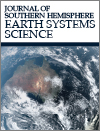Journal of Southern Hemisphere Earth Systems Science
Volume 72
Number 1 2022
The Australian Australian Community Climate and Earth-System Simulator city model (ACCESS-C2) provided improved forecasts due to a Unified Model code upgrade and regional (ACCESS-R2) nesting but mostly due to its ability to run as a convection-permitting model with <2 km resolution. This enabled high temporal and spatial resolution cloud features to be simulated, which is of great interest to forecasters and the public. Fractions Skill Score analysis emphasises the shortcomings of traditional skill scores used in verifying such high-resolution forecast skill. C2 paved the way for the latest operational forecast (C3) and ensemble (CE3) models and further development of higher resolution (down to 300 m) urban models.
Destruction of stratospheric ozone over Antarctica in the spring of 2020 was relatively severe, and strongly contrasted with the situation in 2019 when extreme climate conditions produced a very small ozone hole. A key factor in 2020 was the relative stability of atmospheric motions above Antarctica, which appeared to be favoured by the prevailing large-scale climate patterns. Follow-on effects of the 2020 ozone hole included the moderation of temperatures in parts of Antarctica and Australia during the 2020/2021 summer.
Droughts can initiate during different seasons across Australia; however, they are more likely during certain seasons for a given location. In contrast, drought termination is less seasonal in nature at most locations due to the nature of the short-term extreme rainfall events that tend to end droughts. Using a mix of local and remote climate data, with a region-specific focus, can help to predict drought onset and termination. This work explores how we can possibly predict when droughts are most likely to start and end with an aim to improve drought management.
The CSIRO Climate Analysis Forecasting Ensemble (CAFE) system has produced a comprehensive, temporally and spatially continuous set of coupled climate system outputs over the period 1960–present using state-of-the-art assimilation and forecasting modelling systems. CAFE-60 is principally aimed at the research community focused on understanding global climate variability and predictability, but during its development specific needs of Australia applications were taken into account. A subset of this larger set has been carefully and independently combined with other modelling centres to produce the World Meteorological Organization's (WMO) Global Annual-to-Decadal Climate Update, the most recent released on 27 May 2021. This paper describes aspects of the technical and logistical steps that achieved this outcome by describing key features of the modelling systems, the formal process of becoming a Global WMO Data Producing Centre for near-term climate prediction and a summary of the data products that were exchanged. Several visual descriptions of key climate indices have been included, where possible compared to observations, to help potential users of the data understand the scope and applicability of the analysis and forecast behaviour to their own needs.
Marine heatwaves in recent years have impacted coastal regions of New Zealand and affected local marine ecosystems and aquaculture industries. Here we assess the ability of the Australian Bureau of Meteorology’s seasonal prediction system to forecast extreme marine heat events in key coastal regions several months ahead of time. Notably, for the 2018/2019 Tasman Sea Marine Heat Wave, we found the forecasts did very well a month ahead of time, but this skill dropped off further into the future.
 , Ilia Bermous, Gary Dietachmayer
, Ilia Bermous, Gary Dietachmayer  , Joan Fernon, Jim Fraser, Wenming Lu, Susan Rennie, Peter Steinle
, Joan Fernon, Jim Fraser, Wenming Lu, Susan Rennie, Peter Steinle  and Yi Xiao
and Yi Xiao



